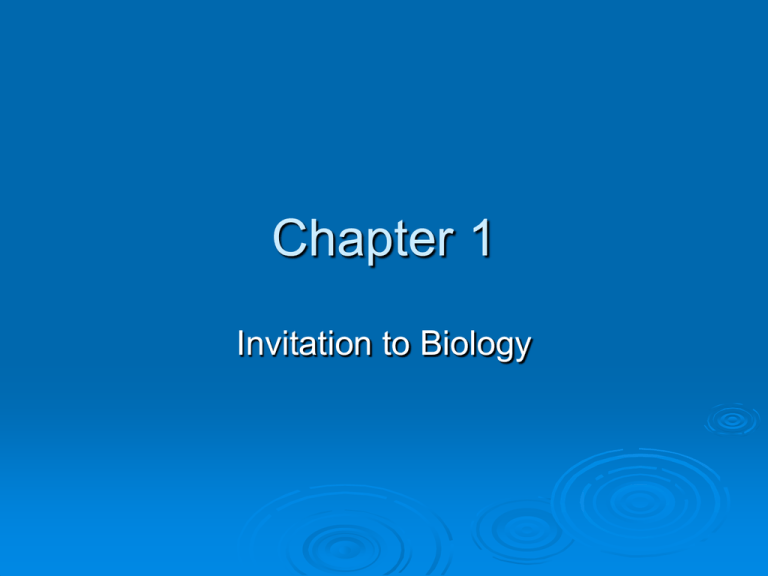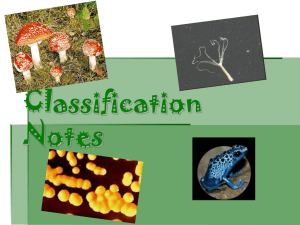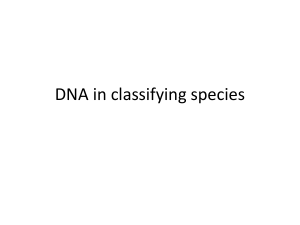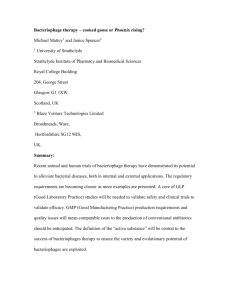
Chapter 1
Invitation to Biology
Objectives
List the levels of organization in the living world.
List the distinguishing characteristics of living
organisms.
Describe the general pattern of energy flow
through Earth’s life forms, and explain how
Earth’s resources are used again and again
(cycled).
Explain what is meant by the term diversity, and
speculate about what caused the great diversity
of life forms on Earth.
Objectives (cont.)
Explain how people came to believe that the
populations of organisms inhabiting Earth have
changed through time.
List as many steps of the scientific approach to
understanding a problem as you can.
Understand as well as you can what limitations
are imposed on science and scientists.
What am I doing here?
Current
world events seem chaotic.
Oil spills that threaten aquatic life.
Diseases such as AIDS destroy lives.
Even the global temperatures seem to be
unstable. (Global warming?)
But
past world events also have been
destructive too. (Bioterrorism, Spanish flu)
Section 1.1 Biology
Biology
Biology
is the scientific study of life
lays the foundation for asking
basic questions about life and the natural
world
Why Study Biology?
To
learn how organisms are constructed,
how they function, where they live, and
what they do
To
help develop, modify, and refine ideas
about life
Levels of Organization
A
general pattern of organization in nature
begins with atoms and molecules.
Each kind of organism, or species,
consists of one or more cells.
The
cell, composed of “biological
molecules,” is the smallest unit of life.
Levels of Organization
Multicelled organisms have increasingly
complex levels of organization:
tissues
organs
organ systems
organisms
populations
communities
ecosystems
biosphere
Emergent Properties
Emergent
properties- a new property that
emerges through interactions of entities at
lower levels, none of which displays the
property.
(ex. Living cells that emerge from “lifeless”
molecules)
1.2 Nothing Lives without
Energy
Energy = Capacity to do work
All cells need energy to stay alive
Metabolism = Reactions by which
cells acquire and use energy to
grow, survive, and reproduce
Interdependencies among
Organisms
Producers
Make their own food
Consumers
Depend on energy stored in tissues
of producers
Decomposers
Break down remains and wastes
Energy Flow
Usually starts with energy from the sun
Transfer from one organism to another
(lose energy in the form of heat)
Energy flows in one direction from
producers to consumers
Eventually, all energy flows back to the
environment
Unity of Life
All organisms:
Are composed of the same substances
Engage in metabolism
Sense and respond to the environment
Have the capacity to reproduce based
on instructions in DNA
Sensing and Responding
Organisms
sense changes in their
environment and make responses to them
Receptors
detect specific forms of energy
(stimuli)
maintenance of homeostasis –
internal environment conditions are
tolerable
Allows
Molecules of Life
All
things are made up of the same units of
matter
Living things are made up of a certain
subset of molecules:
Nucleic acids
Proteins
Carbohydrates
Lipids
DNA (deoxyribonucleic acid)
Signature
Molecule
Directs
molecule of life
of inheritance
assembly of amino acids
DNA and Inheritance
Inheritance
Acquisition of traits by way of
transmission of DNA from parent to
offspring
Reproduction
Mechanism by which an organism
produces offspring
Governed by instructions in DNA
DNA Guides Development
Multicelled
Series
organisms develop
of stages
Instructions
for each stage in DNA
1.3 Diversity of Life
Our
world possesses abundant
diversity, with an estimate as high
as 100 million species existing
today.
Millions
more are now extinct
Classification
schemes attempt to
organize diversity
Scientific Names
Devised
First
by Carolus Linnaeus
name is genus (plural, genera)
Homo sapiens - genus is Homo
Second
name is species within genus
Groupings were added
genera
– least inclusive
family
order
class
phylum
kingdom
Domain
– most inclusive
Comparison of Life’s Three
Domains
6 Kingdoms
Protistans
Plants
Fungi
Animals
Eukaryotes
Archaebacteria
Eubacteria
Origin of life
Prokaryotic
Organisms
Single
No
Eukaryotic
Organisms
cells
Single-
nucleus or
celled
organelles
Smaller,
complex
less
or multi-
Nucleus
and other
organelles
Larger,
more
complex
1.4 Mutation: Source of
Diversity
Mutation
Basis
Most
= change in structure of DNA
for the variation in heritable traits
are harmful, some are beneficial
Charles Darwin
First, members of a natural population will
compete for limited resources, such as food and
shelter, as their size increases.
Second, some varieties of the individuals’
heritable traits will improve survival and
reproductive chances.
Third, those with the adaptive forms of these
traits will be more likely to reproduce and pass
the adaptive traits on with greater frequency in
future generations (natural selection).
Evolution
Genetically
based change in a line of
descent over time
Population
changes, not individuals
Artificial Selection
Breeders
are selective agents
Individuals
exhibiting favored traits are
bred
Favored
traits become more common in
population
Natural Selection
Individuals
vary in some heritable traits
Some forms of heritable traits are more
adaptive
Natural selection is differences in survival
and reproduction among individuals that
vary in their traits
Adaptive forms of traits become more
common than other forms
Antibiotic Resistance
Antibiotics
are used to kill bacteria
Mutations
for antibiotic resistance exist or
arise
Antibiotic-resistant
bacteria survive and
reproduce better than nonresistant
Over
time, proportion of antibiotic-resistant
bacteria increases
1.5 Scientific Method
Observe
phenomenon
Develop
hypotheses
Make
predictions
Devise
Carry
test of predictions
out test and analyze results
Inductive Logic
Using
observations and facts to arrive at
generalizations or hypotheses
Observation:
Eagles, swallows, and robins
have feathers
Hypothesis:
All birds have feathers
Deductive Logic
Drawing
a specific conclusion based on a
generalization
Generalization - Birds have feathers
Example - Eagles are birds
Conclusion - Eagles have feathers
Scientific Theory
A
hypothesis that has been tested for its
predictive power many times and has not
yet been found incorrect
Has
wide-ranging explanatory power
Darwin’s theory of evolution by natural
selection
1.6 Role of Experiments
Used
to study a phenomenon under
known conditions
Allows
you to predict what will happen if a
hypothesis is not wrong
Can
never prove a hypothesis 100%
correct
Experimental Design
Control
group
A standard for comparison
Identical to experimental group except for
variable being studied
Sampling
error
Nonrepresentative sample skews results
Minimize by using large samples
Example of field experiment
Durrell
Kapan confirmed Mullerian mimicry
(look alike) with an experiment in the
forests of Ecuador.
He was able to show that birds that had
“learned” to associate yellow markings
with unpalatability of one species of
butterfly
Fig. 1-11, p.13
Biological Therapy Experiments
Can we use viruses that attack bacteria
(bacteriophages) to fight infections?
See pages 208-209 in textbook.
Experiment 1
Hypothesis
- Bacteriophages can protect
mice against infectious bacteria
Prediction
- Mice injected with
bacteriophages will not die as a result of
bacterial injection
Experiment 2
Prediction
- Bacteriophage injections will
be more effective treatment than single
dose of the antibiotic streptomycin
Test
- Mice injected with bacteria, then
with saline, streptomycin, or bacteriophage
Minimizing Variables
All
mice were same age and sex, reared
under same conditions
Each mouse in each test group received
exact same treatment
All mice in control group received same
amount of saline
Variable tested was antibiotic treatment
versus bacteriophage treatment
1.7 Limits of Science
Science
is limited to questions that can be
tested.
1.Subjective questions cannot be
tested.
2.All of human society must participate
in moral, aesthetic, and other such
judgments.
Limits of Science
Science
may be considered controversial
when it offers explanations for an aspect
of nature previously considered
supernatural
Supernatural explanations cannot be
tested
Conflict with supernatural beliefs- heresy
Copernicus
Darwin
Scientists Raise Questions
The external world, not internal conviction,
must be the testing ground for scientific
beliefs










